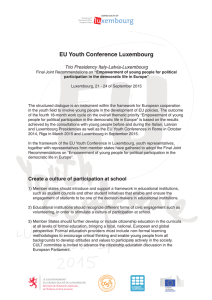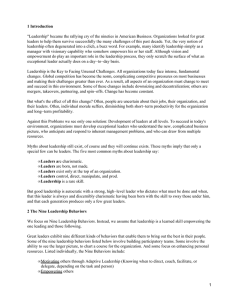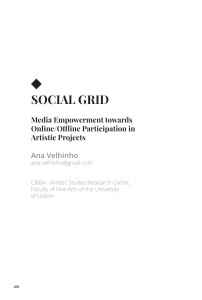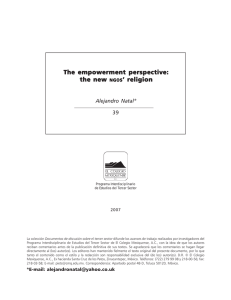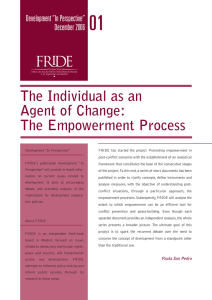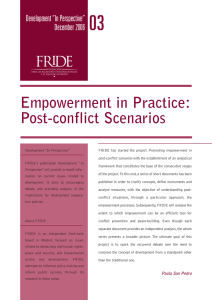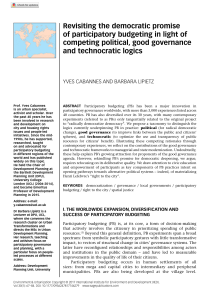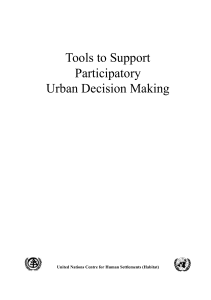Chapter 8: Communication for empowerment. The practice of
Anuncio
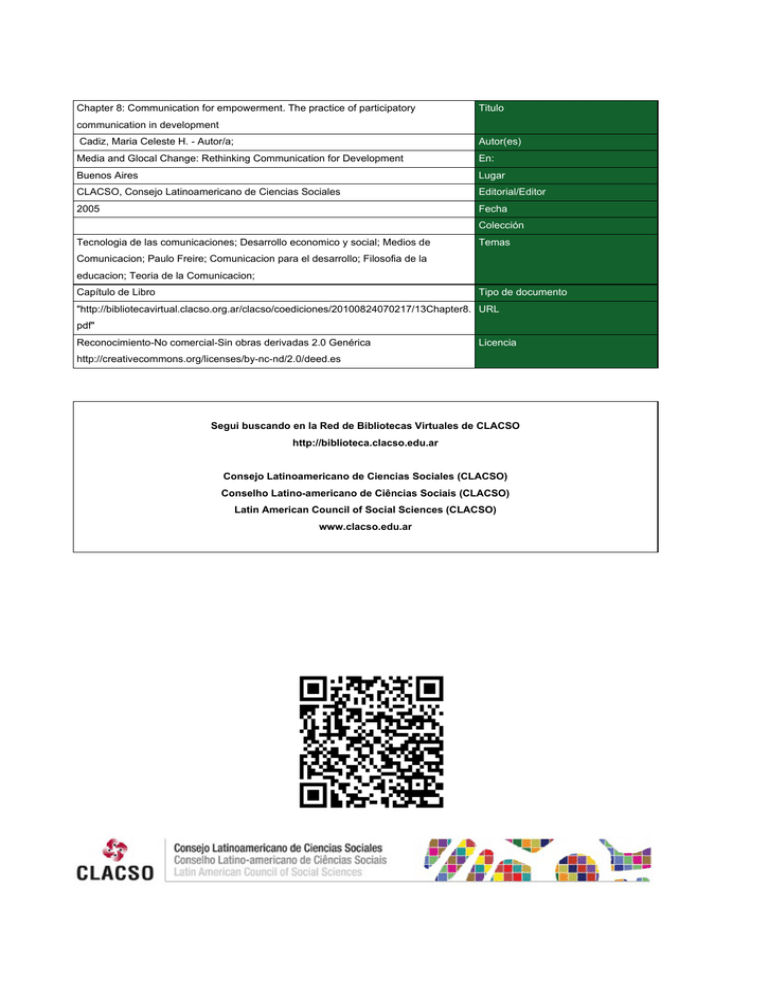
Chapter 8: Communication for empowerment. The practice of participatory Titulo communication in development Cadiz, Maria Celeste H. - Autor/a; Autor(es) Media and Glocal Change: Rethinking Communication for Development En: Buenos Aires Lugar CLACSO, Consejo Latinoamericano de Ciencias Sociales Editorial/Editor 2005 Fecha Colección Tecnologia de las comunicaciones; Desarrollo economico y social; Medios de Temas Comunicacion; Paulo Freire; Comunicacion para el desarrollo; Filosofia de la educacion; Teoria de la Comunicacion; Capítulo de Libro Tipo de documento "http://bibliotecavirtual.clacso.org.ar/clacso/coediciones/20100824070217/13Chapter8. URL pdf" Reconocimiento-No comercial-Sin obras derivadas 2.0 Genérica Licencia http://creativecommons.org/licenses/by-nc-nd/2.0/deed.es Segui buscando en la Red de Bibliotecas Virtuales de CLACSO http://biblioteca.clacso.edu.ar Consejo Latinoamericano de Ciencias Sociales (CLACSO) Conselho Latino-americano de Ciências Sociais (CLACSO) Latin American Council of Social Sciences (CLACSO) www.clacso.edu.ar Chapter 8 Communication for empowerment The practice of participatory communication in development1 Maria Celeste H. Cadiz Back in 1993, when I was leading the transfer of a project to a new site, I found myself trying to explain to town and village officials about 120 km southwest of Manila that our project was aiming for people empowerment. “The project aims to empower the villagers”, I explained sincerely and with comfort that I was mouthing a previously threatening phrase that was by that time already associated with the establishment2. “This is if you will permit us to carry out our project in the village under your jurisdiction”. We were met with reflective silence and polite questions. It was several months later when our partners in the village disclosed their impressions as we, in our own words, attempted to woo them to grant permission to undertake a foreign-funded project coordinated by a national agency in their village. To the town mayor and village officials, we were suspect. Coming from a state university sometimes notorious for producing insurgents with strong communist and socialist leanings and mouthing these words, these people must be leftists, they thought, which they later admitted to us. This was 1993, seven years after the decline of martial rule in the Philippines under the term of its sec1 Key reflections in this article were originally drawn out in discussions with colleagues Ma. Ciejay J. Calara and Ma. Teresita B. Osalla based on their and the author’s involvement in development communication projects. They were first presented in a Lecture Series and subsequently published in Rola & Foronda (2003) p. 301-315. 2 Then President of the Philippines Fidel V. Ramos used the phrase as his election campaign slogan, and kept repeating the slogan in advocating his programs while in office. | 145 Media and Glocal Change 146 | ond post-martial law president. The then president of the republic was mouthing “people empowerment” as a slogan and I felt it safe and acceptable to echo a development paradigm I believed with conviction. Defining participatory communication for development How does participatory communication for development work, which capitalizes first and foremost on empowered partners? Why the emphasis on participatory approaches and empowerment? In answer to these questions, I would like to excerpt from a synthesis I recently posted in a web-based forum on participatory development communication (PDC) in community-based natural resource management (CBNRM): Being participatory for the sake of being participatory is not the important issue –rather, the real issue is the reason behind why an NRM (or development) initiative should involve the people in community– so that they feel ownership of the NRM (or development) research or action project; so that it truly addresses their needs from their own perspective; and as such, so that they will commit to see the NRM (or development) initiative through until it is completed. Participation of the people enables us to devote our efforts and resources to concerns that they share and consider important. It builds up people’s confidence and capabilities to undertake or again involve themselves in future initiatives to address other NRM and development concerns. In short, the NRM (or development) initiatives become sustainable” (parentheses supplied). Bessette (2004) defines participatory development communication as “a planned activity, based on the one hand on participatory processes, and on the other hand on media and interpersonal communication, which facilitates a dialogue among different stakeholders, around a common development problem or goal, with the objective of developing and implementing a set of activities to contribute to its solution, or its realization, and which supports and accompanies this initiative”. Servaes (2003) elaborates participatory communication for development as where the point of departure must be the community: It is at the community level that the problems of living conditions are discussed, and interactions with other communities are elicited. The most developed form of participation is self-management. This principle implies the right to participation in the planning and production of media content. However, not everyone wants to or must be involved in its practical implementation. More important is that participation is made possible in the decision-making regarding the subjects treated in the messages and regarding the selection procedures. Beyond the micro or community/local level, participatory communication in development also applies at the international, national, as well as project management Maria Celeste H. Cadiz (organizational) and individual level. Its foundation is in Freire’s (1970) basic model of the dialogue, originally asserted in the context of educating the underdeveloped sectors of society, now considered an important development communication model. Fig.1. Freire’s dialogue A Communiqué B Five characteristics of Freire’s dialogue A closer study of Freire’s model informs us on how best to proceed with participatory communication in development. Practitioners should mind that five interrelated attributes or qualifiers of the dialogue are in place if they are to employ participatory approaches in development. 1. Communication between equals. First, the model emphasizes equality between the change agent and the development partner. “Teacher” and “student”, “extensionist” and “farmer”, “expert” and “user”, “communicator” and “audience”, and “sender” and “receiver” interchange roles in a mutually beneficial two-way interaction. The redundancy in the preceding statement is intentional for purposes of emphasis. Our paradigm shifts from a view of our counterparts as development “beneficiaries” (“objects”) to that of development “partners” and “colleagues” (fellow “subjects”). Freire thus differentiated his dialogue, which in the translation of his work was labeled “intercommunication”, from a communiqué or top-down directive or memo where one party assumes a superior role and his/her counterpart is ascribed the subordinate role. In the same vein, Servaes (2003) observed that participatory communication stresses reciprocal collaboration throughout all its levels, citing MacBride et al’s (1980) argument promoting “more understanding of diversity and plurality, with full respect for the dignity and equality of peoples living in different conditions and acting in different ways”. 2. Problem-posing. Freire likewise qualifies his model as a problem-posing dialogue, contrasted to a “banking-type” of education where teachers, trainers, extensionists, or development communicators merely “deposit knowledge”, expecting the development “object” (in contrast to a self-determining “subject”) | 147 Media and Glocal Change 148 | to be able to “withdraw” these when the need arises. On the other hand, a problem-posing dialogue or participatory communication draws from the learner’s or people’s stock knowledge, experiences, and insights, eliciting these by raising relevant thought-provoking questions rather than merely presenting prescriptive solutions to development problems. In this sense, Freire’s educational philosophy does not depart much from that of ancient Greek philosopher Socrates, who emphasized dialectic reasoning through question and answer. The model shifts the role of development communicators from just serving as transmitters, conveyors, translators, and disseminators of relevant information, to that of facilitators of a process of social change capitalizing on human learning at the individual level and in community. This shift in paradigm places lesser burden on the communication specialist to single-handedly choose and provide needed answers to fill information gaps associated with development needs and problems. On the other hand, this view of the communicator as facilitator adheres to the notion of development as a self-determined and self-initiated process best sustained when it is not artificially imposed from outside the community. The communicator can best perform his/her role in development as facilitator, consensus-builder, mediator (Quebral, 2001), and conflict negotiator if guided closely by Freire’s dialogic method. A communication theory patterned after the Freire model is Kincaid’s (1979) convergence model, which presupposes the goal of communication to be mutual understanding. 3. Praxis, a cycle of action and reflection. Translated into communication practice in development, a change agent refrains from lecturing and recommending development solutions without first drawing out from users their needs, own analysis of the development problem and its possible solutions, and requests for technical information. Instead, s/he adopts the adult education approach of capitalizing on the people’s experiences, an inductive approach to teaching that first analyses practice, then by reflection draws from such analysis theories and generalizations in the form of lessons learned. In his most influential book Pedagogy of the Oppressed, Freire (1970) expounds on knowledge (which the book’s English translation labeled as “the word”) being the result of praxis or the cycle of action and reflection. Action is the practical application of knowledge while reflection corresponds to abstraction and theorizing. In practical terms, knowledge is incomplete without one or the other, but is richer when theory and practice are highly integrated. Tungpalan and Bulsara (1981) as cited by Cadiz (1994) noted that too much action and too little reflection is activism, while too much reflection and too little action, verbalism. Development work thus involves engaging in action with partners, in the process learning with them in alternating activities and evaluations or reviews of actions taken. Participatory development communication is thus best studied and theorized in action, perhaps from a critical perspective. Maria Celeste H. Cadiz 4. Conscientizing. Freire expounds on conscientization, a process of advancing critical consciousness. In a dialogue, development partners, as deliberate, construing, and goal-seeking participants, grow in understanding human, social and development processes. In this process, participants increase their willingness to take risks. They become a party to or stakeholders of social change, based on a conscious decision to engage in such change, uncomfortable as conditions brought about by change may be, and based on a deeper understanding of their realities. In praxis, therefore, conscientization takes place. A good measure of whether participatory development communication proceeds fruitfully is when development partners’ conscientization becomes evident. A challenge for researchers and practitioners is coming up with indicators or evidences of conscientization, often seen not in individual behaviors but in mechanisms and systems collectively put up by people in community. This is aligned with Chu’s (1987) recommendation for development communication research and evaluation to direct its attention less on individual behavior and psychological variables to “institutional effects”. I call them “system level” effects from a systems perspective. For example, did the community set up its own version of a communication center or library? Did the village officials institute a new policy or regulation providing a mechanism for people’s participation in their deliberations? Further, conscientization is not only for development partners in community. As active participants in a dialogue between equals, it should also be evident in the change agent and development sponsors, managers, and facilitators coming from international, government, and nongovernment agencies, and the academe. For example, have administrative procedures been revised to allow a certain degree of flexibility accommodating people’s agendas? 5. Five values. Finally but not the least, Freire explicitly states that the “true” dialogue happens in a context of five overriding values: love, humility, hope, faith in development partners’ capability, and critical thinking –values that a classical and empirical social scientist would rather avoid for their “vagueness” and “subjectivity”. True to the qualitative researcher’s ontological assumption of multiple realities, however, followers of Freire’s dialogic approach to development openly claim this subjectivity and leaning in favor of resource poor partners. These values can be translated into interpersonal communication protocols such as giving priority to active and non-judgemental listening over expressing oneself, much akin to Covey’s (1989) habit no. 5 of highly effective people, “seek first to understand, then to be understood”. Hope is related to Covey’s habit no. 4, the win-win mindset or the abundance mentality. Elements of communication for empowerment In initiatives in communication for development that I and colleagues at the College of Development Communication, University of the Philippines, Los Baños, | 149 Media and Glocal Change 150 | have participated in, common practical elements in communication for empowerment are present, as follows: 1 Provision of access to information. Based on the traditional view of development communication as a means to disseminate technical information towards productivity, food security, and environmental conservation, this is often the primary justification for a communication component in development programs. In a project that organized rural communities to operate their own low-powered radio stations, people living in remote areas were given access to information that would not normally be readily available to them. This is the same emphasis of communication centers in rural Philippines and telecenters in India. In our university town rich in scientific and academic information and knowledge, a community cable television program provided information on current events and on the community itself, aiming to contribute to a community mindset in the municipality. A mechanism to circulate such community information was previously lacking in the town. 2 Putting users/beneficiaries and local people in control. The essence of empowerment is control, where local people’s control spells faithfulness to Freire’s participatory approach. This element is exemplified by projects that equip local people to manage and oversee appropriate media facilities such as community public address systems, low-powered radio stations, and simple communication centers and telecenters. 3 Building local people’s capabilities in communication. A prerequisite of putting local people in control of development processes where communication is an integral component is the building up of local people’s capabilities. Training of local people or cooperators in communication skills, such as in community broadcasting, community or village journalism, computer skills, and Internet surfing; as well as in discernment of the relevance of information and their proper use/application, are necessary. Often, what are overlooked are interpersonal communication skills including personal empowerment and value reaffirmation, which are more basic requirements in participatory communication. Likewise, managerial skills such as problem-solving and decision-making skills are fundamental. Conflict resolution and negotiation skills are similarly important. 4 Emphasis on small and appropriate media. Low-powered radio transmitters that allow local broadcasting are examples of small media appropriate for rural communities. So are wall newspapers and blackboard or bulletin board news, as well as audiocassettes, puppetry, and youth theatre. “Small is beautiful” because small is often simpler, easier, and requires less resources to use. Maria Celeste H. Cadiz 5 Learning with partners. Participatory communication for development is a joint learning experience between equals where knowledge-building in it is integral. New approaches, best practices, and insights evolve out of the joint efforts of partners, thereby enriching the discipline grounded on praxis. 6 Working as a collective. Development happens at the community rather than at the individual level. A requisite of participatory development is that beneficiaries or partners should be organized. People are better able to make change happen when their decisions are made as a community or collective. 7 Capitalizing and building on felt needs. Obviously, people will not pay attention to messages that they find irrelevant to their realities. 8 Making it enjoyable. People pay attention and participate in activities that give them satisfaction. Entertainment as a reinforcement is simply the application of learning theory toward behavior change. 9 Giving them hands-on experience. Development means change, change requires learning, and learning by doing is rich and meaningful. 10 Sharing resources. Often, there is only so much of people, funds, materials, machines and time available. But putting what we respectively do best together brings about synergy of efforts. Development as a collective effort also springs from various stakeholders becoming more as shareholders. The process Communication for empowerment is a deliberate and systematic process. Just as Servaes (2003) emphasizes the framework of multiplicity, there is no best, single approach or strategy or communication channel for empowering people. Communication for empowerment is a process rather than a technique. The basic questions we ask ourselves when we engage in such an initiative are: » How do we start? » How do we proceed? » What are the signposts we should watch out for? » What milestones should we aim for? » What next? » What is our ultimate aim? However, we do not need to embark on such an undertaking without any guidelines in the hope of learning through trial and error or “learning by ear”. We proceed through the usual project management cycle of pre-planning, planning, implementation, evaluation and re-planning. Five generic steps synthesizing elab- | 151 Media and Glocal Change 152 | orate models like FAO’s Development Support Communication (DSC), USAID’s Communication for Technology Transfer in Agriculture (CTTA), FAO’s Strategic Extension Campaigns (SEC) (Oliveira, 1993), and Johns Hopkins University’s strategic communication and social marketing are as follows: 1 Assessment (development investigation) 2 Planning (strategy development) 3 Materials preparation and message delivery 4 Implementation 5 Evaluation 6 Planning for continuity Simple as the listing of the above steps seems, there is much in how we proceed with each step that can make the process empowering and its impact sustainable. The five characteristics of Freire’s dialogue, translated into the practical elements of communication for empowerment above, can spell the difference. Selected participatory approaches Relevant participatory approaches, most of which are directly grounded on Freire’s model and educational philosophy, include community organizing (CO), action research, participatory action research (PAR) or participatory research (PR), and social mobilization (socmob) with its components advocacy and networking. Community organizing (CO) is a problem-solving approach whereby the community is empowered with the knowledge and skills to identify and prioritize its needs and problems, harness its resources to deal with these problems and take action collectively (Patron, 1987 cited by Cadiz, 1994). A community organizer plays a key role in facilitating the process. CO proceeds in three stages with eight, four and two steps respectively, as follows: 1 Awakening - a) area selection, b) entry into the community, c) social investigation/community study, d) integration, e) contact-building and spotting of potential leaders, f) core group formation, g) core training and mobilization, and h) formation of community organization; 2 Empowerment - a) program planning, b) project planning, c) implementation, and d) evaluation; and 3 Restructuring - a) phase-out and b) establishment of a new system of work relationship (Lucas, 1991 cited by Cadiz, 1999). Cadiz (1999) further noted: In a community where people are passive recipients of changes in wider society and are locked up in dehumanizing poverty and other social ills, Maria Celeste H. Cadiz community organizing is an intensive process of awakening people’s critical consciousness and developing their leadership capabilities to take action on their development problems. Many communities in the Philippines had gone past the awakening stage, where the arduous task of conscientization can now be bypassed and the people’s involvement in the project management cycle in the empowerment stage is the main concern (Cadiz, 1999). Action research, which is more of an approach to undertaking and studying communication in development, is defined as a type of applied social research differing from other varieties in the immediacy of the researcher’s involvement in the action process (Rapoport as cited by Foster, 1972). It aims to contribute both to the practical concerns of people in an immediate problematic situation and to the goals of social science by joint collaboration with a mutually acceptable ethical framework. Both the people and the researcher intend to be involved in a process of changing the system itself. Action research proceeds logically in six systematic steps, namely, 1) analysis, 2) fact-finding, 3) conceptualization, 4) planning, 5) execution, and 6) more fact-finding/ evaluation, in a spiraling circle. In essence, action research is the application of the scientific method in dealing with social problems, with the aim of promoting people’s liberation and growth. I commented in 1999, In my view, development communication is best studied in action, or as action research. The urgency of the need to take action, often innovative in nature, on development problems and issues makes action research the most relevant approach to the practice and study of development communication. Not only can action research in development communication contribute to knowledge-building in the field, it likewise enables testing and refinement of initiatives that can create immediately-needed development impact (Cadiz 1999). Participatory action research (PAR) or participatory research (PR) is a form of action research, taking its questions from the perceptions of practitioners within local contexts and building description and theories within the practice context itself and tests them there. Its only difference from action research is that in PAR or PR, practitioners are subjects as well as co-researchers (Argyris and Schon 1985). PAR has three dimensions as 1) a method of social investigation, 2) an educational process, and 3) a means of taking action for development (Ferrer and Pagaduan, 1981 as cited by Cadiz, 1994) where the role of the professional researcher is primarily to complement people’s initiative and efforts. Among PAR/PR and community organizing advocates in the Philippines, PAR/PR and CO are often used interchangeably. However, PAR/PR seems to place greater emphasis on the component of social research in action than CO, while the latter is oriented more towards action and problem/issue solving. | 153 Media and Glocal Change 154 | Social mobilization is the process of bringing together all feasible and practical intersectoral and social allies to raise people’s awareness of and demand for a particular development program, to assist in the delivery of resources and services and to strengthen community participation for sustainability and selfreliance (McKee, 1992). The UNICEF characterized social mobilization as a selfsustaining process; a multilevel approach that is both bottom-up and top-down; based on an in-depth and comprehensive understanding of a country’s socio-cultural and politico-economic contexts; carefully planned and costed for feasibility so as to ensure that demand created in the mobilizing process is met; intensified programming at selected pressure points; a dynamic process requiring a fastmoving support response. Social mobilization uses the five approaches of political mobilization, government mobilization, community mobilization, corporate mobilization, and beneficiary mobilization (McKee, 1992). Advocacy is the organization of information into argument to be communicated through various interpersonal and media channels with a view to gaining political and social leadership acceptance and preparing a society for a particular development program (McKee, 1992). As the term implies, it is persuasive communication for or against an issue or concern. The major audiences of advocacy are leaders and funding agencies –decision-makers who have the say as to how resources are allocated. Thus, the main purpose of advocacy is to generate support for a project in terms of funding allocation or some commitment of resources. Wide acceptance of a project or its cause is also an important goal of advocacy, because political leaders will support a cause that has popular backing. Interpersonal communication plays a key role in advocacy initiatives, where mediated communication is often used as supplement and as message reinforcement. Networking and alliance-building with other organizations, sectors or communities is a strategy of community organizing aimed to enhance the strength of one’s position most especially in advocating a cause or socially-desirable action or program. In social mobilization, we need to identify our allies, or other persons, organizations or movements having similar interests and programs as ours (Cadiz, 1999). A program can form alliances or networks with a wide variety of organizations and entities, such as different types of nongovernment organizations including civic organizations, private voluntary organizations, nonprofit foundations, cooperatives, church-related associations and the church, among others. Likewise, government agencies with which a program may link with include line agencies, research and development agencies, service providers, local governments and their units, among others. Influential private individuals and political leaders can also be powerful allies, as well as local, national and international funding agencies (Cadiz, 1999). In a society or community where development goals converge, alliance-building is a strategic move to produce desired impact in such a society or Maria Celeste H. Cadiz community. It provides for resource sharing and synergy of efforts among various sectors toward common goals. The following concerns in society are those where various sectors’ goals are often seen to easily converge: environmental conservation, health and sanitation, moral and cultural upliftment, poverty alleviation, and disaster and crisis assistance and management (Cadiz, 1999). Components of communication for empowerment In communication initiatives toward empowering people for development, we now recommend the inclusion of the following components, not necessarily in their order of priority or chronology: 1 Communication training. Development communicators must remember that they cannot monopolize nor accomplish all the devcom work that needs to be done. Because communication is intrinsic in all human processes and therefore a key in development initiatives, all persons and entities involved need to be equipped with better communication skills. It is better if these are development communication skills, or communication skills infused with a clear vision of and bias for development. 2 Communication planning and strategizing. We recommend postponing the identification of a specific communication channel or technique until a communication plan is made. This planning process should adhere to the process described above, with proper consideration of the context in which they will be used and preferably participated in by partners and beneficiaries. 3 Communication media design and production. Often, development communication is perceived to be solely focused on media materials design and production. However, this aspect ought to be properly placed within an overall communication plan arrived at in a rational manner and mindful of a participatory development process. 4 Communication technology. Beyond the design and production of devcom materials is a need for the application and even further innovation of appropriate communication technology. Here, convergence among technologies is observed to be a contemporary phenomenon and needs to be anticipated and incorporated. 5 Communication utilization center. Access to information is a key to empowerment, and so is the availability of options. Agencies and organizations of various natures and persuasion produce many different communication materials, and often all that is needed is for users and information-seekers to have access to them. 6 Communication archiving/data banking. As information and knowledge mounts in this information age, what is needed is the manage- | 155 Media and Glocal Change 156 | ment of information to enable users to sift through and select those that are useful. Knowledge management applied in development is an emerging concern in development communication. 7 Communication evaluation. Because development communication is best studied in action, evaluation ought to be built in every stage from preplanning to post-implementation. All these communication components will be uniquely configured as they would be closely tied with the specific development subject matter or concern in question, with its unique set of stakeholders, be it in food security, natural resource management, health, child rights, poverty alleviation and livelihoods, land reform, and so on. Some lessons in communication for empowerment The following lessons are drawn from reflections on successes, difficulties, and frustrations in my and colleagues’ involvement in participatory development communication projects. Many who engage in development work already know or at least have a sense of many of these lessons. Thus, it is more appropriate to label these as “lessons reinforced” rather than “lessons learned”: 1 If we are to carry out approaches toward empowering people, we should start with a clear definition or set of indicators of empowerment. From our experience, communication empowerment includes the following dimensions. a Participants can fulfill their basic needs (food, shelter, peace). b Participants have high self-esteem and foster such in others. c Participants can or are enabled to exercise their power to choose because: » They have or can access information needed in making decisions. » They have the know-how needed to be able to make sound decisions and address problems (application of scientific method, decision analysis skills). » They are free to decide, unhampered by inequitable cultural, social, religious, ethnic, gender, physical and political factors. d Participants exercise their choice in order to fulfill their human potential (not to destroy themselves). e Participants have a community or collective mindset. 2 Central in the enabling process of people empowerment is value formation or reinforcement. We have seen how many development programs have fallen short of their expectations largely due to the lack of values among participants. 3 Paradigms and mindsets may need to be shifted first in embarking on action for empowerment. Empowerment is a different paradigm or Maria Celeste H. Cadiz mindset to development altogether compared to delivery and diffusion of services, information and other benefits. It produces a more sustainable impact but it works with a different set of assumptions. Many times, the shift in mindset is needed foremost in the advocate or sponsor of development –we ourselves, our researchers, our institutions, our extensionists and partners in the countryside. 4 Building of leadership qualities and communication know-how is also essential; hence these competencies should always be incorporated in technical capability building. Technical capability can be cancelled out by the lack of leadership and communication competence, but produce impact a hundredfold coupled with these qualities. 5 Communication for empowerment involves more listening and facilitation of dialogue than delivering information, more learning together than teaching the other. 6 In nurturing a spirit of voluntarism, burnout can be a common consequence. Many of our partners in development fall out in their participation because they need to attend to the realities of their more immediate, basic needs –food, clothing, shelter, and education of the children. Or, our partners can become over-committed with the various aspects of voluntary work. 7 Local politics and religion can contradict and cancel out communication efforts toward people empowerment. Factionalism can be detrimental to development initiatives, and differences in political and religious persuasions are common sources of such division in a community. 8 Who you enroll as partners and their personal characteristics count a lot in determining the success or failure of empowerment efforts. There are times when it is simply tough luck for us to find out later that we chose the wrong cooperators or the wrong community because we were unable to carefully screen them for absorptive capacity for empowering initiatives. Personality traits, such as diligence, trustworthiness, commitment, service-orientation and dedication, especially of leaders, play a big role in the potential success of a development project. 9 An indication that empowerment has been achieved is that new projects are initiated and sustained in the locality. Sad to say, this indicator is often not observed within the duration of a project, but some time after its termination. This impact often takes more time to gel than a specified duration of a project. 10 All partners need to appreciate the role of communication in their development –a large part of development communication practice should include development communication advocacy. Communication is integral as a planning, implementing and evaluation mechanism in all devel- | 157 Media and Glocal Change 158 | opment projects, whether or not its proponents recognize this. Development communication specialists cannot do all the communication work for development. Their role should be to empower all stakeholders in development with communication skills coupled with a clear vision of and orientation for development. 11 Project failure is often rooted in poor project management, not in inadequacies of the project environment. The call for evidences A nagging question that funding agencies are concerned with is: does participatory communication really spell a difference in development initiatives? Is investment in this human dimension of development worth it? Thus our challenge is in showing how participatory approaches work well compared with initiatives without participation. Funding agencies’ language of success is spelled in dollars and cents, and their decision-makers similarly seek hard (quantitative) evidences of “better” development. Evaluation and research need to present such hard evidences in their language, albeit grounded on a single view of reality. On the other hand, the multiplicity framework raises the validity of subjective, qualitative evidences of people’s conscientization, empowerment, and well-being, as well as of the sustainability of initiatives. Participatory development advocates themselves need to assert the validity of its qualitative, multifaceted dimensions and further develop appropriate monitoring and evaluation models, indicators, and methods. Aligned with this is the need for deliberate knowledgebuilding as we continue to learn, refine, and evolve our participatory development communication approaches while their environment and the context of development continuously change.
